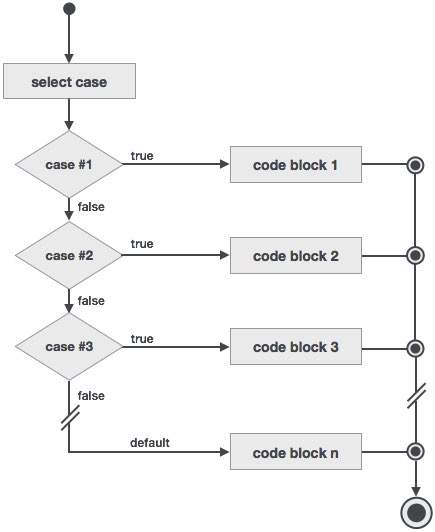
- Fortran - Home
- Fortran - Overview
- Fortran - Environment Setup
- Fortran - Basic Syntax
- Fortran - Data Types
- Fortran - Variables
- Fortran - Constants
- Fortran - Operators
- Fortran - Decisions
- Fortran - Loops
- Fortran - Numbers
- Fortran - Characters
- Fortran - Strings
- Fortran - Arrays
- Fortran - Dynamic Arrays
- Fortran - Derived Data Types
- Fortran - Pointers
- Fortran - Basic Input Output
- Fortran - File Input Output
- Fortran - Procedures
- Fortran - Modules
- Fortran - Intrinsic Functions
- Fortran - Numeric Precision
- Fortran - Program Libraries
- Fortran - Programming Style
- Fortran - Debugging Program
Fortran - select case construct
Aselect casestatement allows a variable to be tested for equality against a list of values. Each value is called a case, and the variable being selected on is checked for each select case.
Syntax
The syntax for the select case construct is as follows −
[name:] select case (expression) case (selector1) ! some statements ... case (selector2) ! other statements ... case default ! more statements ... end select [name]
The following rules apply to a select statement −
The logical expression used in a select statement could be logical, character, or integer (but not real) expression.
You can have any number of case statements within a select. Each case is followed by the value to be compared to and could be logical, character, or integer (but not real) expression and determines which statements are executed.
The constant-expression for a case, must be the same data type as the variable in the select, and it must be a constant or a literal.
When the variable being selected on, is equal to a case, the statements following that case will execute until the next case statement is reached.
The case default block is executed if the expression in select case (expression) does not match any of the selectors.
Flow Diagram

Example 1
program selectCaseProg
implicit none
! local variable declaration
character :: grade = 'B'
select case (grade)
case ('A')
print*, "Excellent!"
case ('B')
case ('C')
print*, "Well done"
case ('D')
print*, "You passed"
case ('F')
print*, "Better try again"
case default
print*, "Invalid grade"
end select
print*, "Your grade is ", grade
end program selectCaseProg
When the above code is compiled and executed, it produces the following result −
Your grade is B
Specifying a Range for the Selector
You can specify a range for the selector, by specifying a lower and upper limit separated by a colon −
case (low:high)
The following example demonstrates this −
Example 2
program selectCaseProg
implicit none
! local variable declaration
integer :: marks = 78
select case (marks)
case (91:100)
print*, "Excellent!"
case (81:90)
print*, "Very good!"
case (71:80)
print*, "Well done!"
case (61:70)
print*, "Not bad!"
case (41:60)
print*, "You passed!"
case (:40)
print*, "Better try again!"
case default
print*, "Invalid marks"
end select
print*, "Your marks is ", marks
end program selectCaseProg
When the above code is compiled and executed, it produces the following result −
Well done! Your marks is 78